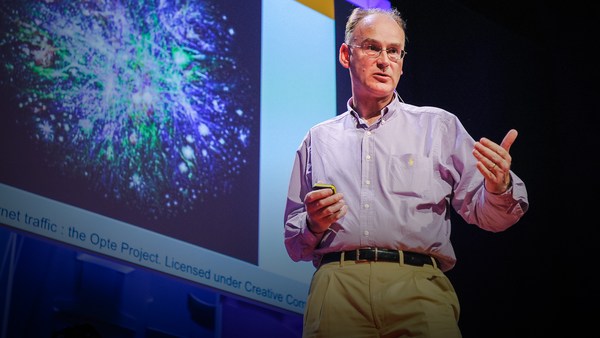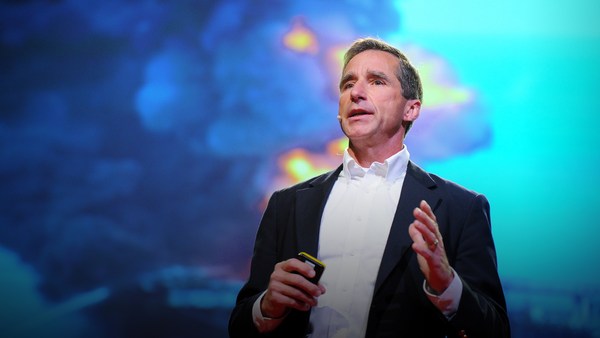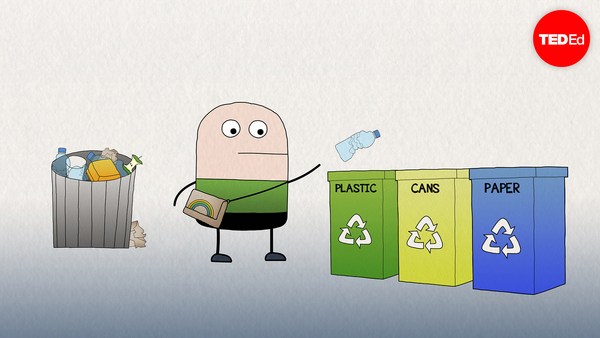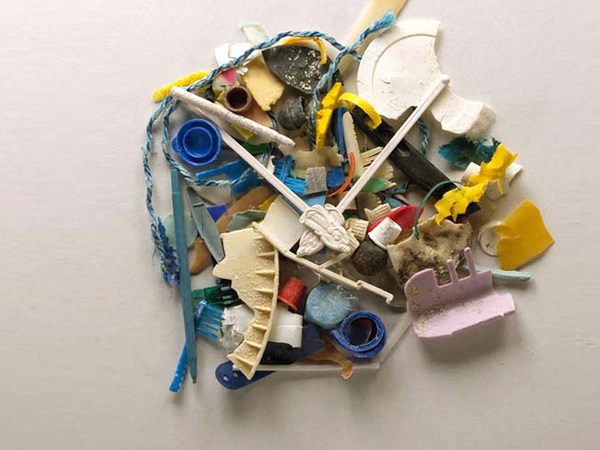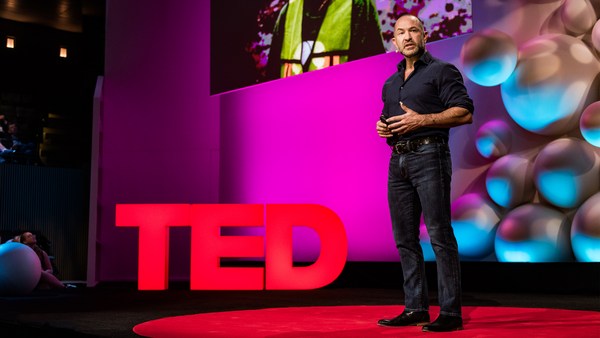If we look around us, much of what surrounds us started life as various rocks and sludge buried in the ground in various places in the world. But, of course, they don't look like rocks and sludge now. They look like TV cameras, monitors, annoying radio mics. And so this magical transformation is what I was trying to get at with my project, which became known as the Toaster Project. And it was also inspired by this quote from Douglas Adams, and the situation is from "The Hitchhiker's Guide to the Galaxy." And the situation it describes is the hero of the book -- he's a 20th-century man -- finds himself alone on a strange planet populated only by a technologically primitive people. And he kind of assumes that, yes, he'll become -- these villagers -- he'll become their emperor and transform their society with his wonderful command of technology and science and the elements, but, of course, realizes that without the rest of human society, he can barely make a sandwich, let alone a toaster. But he didn't have Wikipedia.
So I thought, okay, I'll try and make an electric toaster from scratch. And, working on the idea that the cheapest electric toaster would also be the simplest to reverse-engineer, I went and bought the cheapest toaster I could find, took it home and was kind of dismayed to discover that, inside this object, which I'd bought for just 3.49 pounds, there were 400 different bits made out of a hundred-plus different materials. I didn't have the rest of my life to do this project. I had maybe nine months. So I thought, okay, I'll start with five. And these were steel, mica, plastic, copper and nickel.
So, starting with steel: how do you make steel? I went and knocked on the door of the Rio Tinto Chair of Advanced Mineral Extraction at the Royal School of Mines and said, "How do you make steel?" And Professor Cilliers was very kind and talked me through it. And my vague rememberings from GCSE science -- well, steel comes from iron, so I phoned up an iron mine. And said, "Hi, I'm trying to make a toaster. Can I come up and get some iron?" Unfortunately, when I got there -- emerges Ray. He had misheard me and thought I was coming up because I was trying to make a poster, and so wasn't prepared to take me into the mines. But after some nagging, I got him to do that.
(Video) Ray: It was Crease Limestone, and that was produced by sea creatures 350 million years ago in a nice, warm, sunny atmosphere. When you study geology, you can see what's happened in the past, and there were terrific changes in the earth.
Thomas Thwaites: As you can see, they had the Christmas decorations up. And of course, it wasn't actually a working mine anymore, because, though Ray was a miner there, the mine had closed and had been reopened as a kind of tourist attraction, because, of course, it can't compete on the scale of operations which are happening in South America, Australia, wherever. But anyway, I got my suitcase of iron ore and dragged it back to London on the train, and then was faced with the problem: Okay, how do you make this rock into components for a toaster?
So I went back to Professor Cilliers, and he said, "Go to the library." So I did and was looking through the undergraduate textbooks on metallurgy -- completely useless for what I was trying to do. Because, of course, they don't actually tell you how to do it if you want to do it yourself and you don't have a smelting plant. So I ended up going to the History of Science Library and looking at this book. This is the first textbook on metallurgy written in the West, at least. And there you can see that woodcut is basically what I ended up doing. But instead of a bellows, I had a leaf blower. (Laughter) And that was something that reoccurred throughout the project, was, the smaller the scale you want to work on, the further back in time you have to go. And so this is after a day and about half a night smelting this iron. I dragged out this stuff, and it wasn't iron. But luckily, I found a patent online for industrial furnaces that use microwaves, and at 30 minutes at full power, and I was able to finish off the process.
So, my next -- (Applause) The next thing I was trying to get was copper. Again, this mine was once the largest copper mine in the world. It's not anymore, but I found a retired geology professor to take me down, and he said, "Okay, I'll let you have some water from the mine." And the reason I was interested in getting water is because water which goes through mines becomes kind of acidic and will start picking up, dissolving the minerals from the mine. And a good example of this is the Rio Tinto, which is in Portugal. As you can see, it's got lots and lots of minerals dissolved in it. So many such that it's now just a home for bacteria who really like acidic, toxic conditions. But anyway, the water I dragged back from the Isle of Anglesey where the mine was -- there was enough copper in it such that I could cast the pins of my metal electric plug.
So my next thing: I was off to Scotland to get mica. And mica is a mineral which is a very good insulator and very good at insulating electricity. That's me getting mica. And the last material I'm going to talk about today is plastic, and, of course, my toaster had to have a plastic case. Plastic is the defining feature of cheap electrical goods. And so plastic comes from oil, so I phoned up BP and spent a good half an hour trying to convince the PR office at BP that it would be fantastic for them if they flew me to an oil rig and let me have a jug of oil. BP obviously has a bit more on their mind now. But even then they weren't convinced and said, "Okay, we'll phone you back" -- never did. So I looked at other ways of making plastic. And you can actually make plastic from obviously oils which come from plants, but also from starches. So this is attempting to make potato starch plastic. And for a while that was looking really good. I poured it into the mold, which you can see there, which I've made from a tree trunk. And it was looking good for a while, but I left it outside, because you had to leave it outside to dry, and unfortunately I came back and there were snails eating the unhydrolyzed bits of potato.
So kind of out of desperation, I decided that I could think laterally. And geologists have actually christened -- well, they're debating whether to christen -- the age that we're living in -- they're debating whether to make it a new geological epoch called the Anthropocene, the age of Man. And that's because geologists of the future would kind of see a sharp shift in the strata of rock that is being laid down now. So suddenly, it will become kind of radioactive from Chernobyl and the 2,000 or so nuclear bombs that have been set off since 1945. And there'd also be an extinction event -- like fossils would suddenly disappear. And also, I thought that there would be synthetic polymers, plastics, embedded in the rock.
So I looked up a plastic -- so I decided that I could mine some of this modern-day rock. And I went up to Manchester to visit a place called Axion Recycling. And they're at the sharp end of what's called the WEEE, which is this European electrical and electronic waste directive. And that was brought into force to try and deal with the mountain of stuff that is just being made and then living for a while in our homes and then going to landfill. But this is it.
(Music)
(Laughter)
So there's a picture of my toaster. (Applause) That's it without the case on. And there it is on the shelves. Thanks.
(Applause)
Bruno Giussani: I'm told you did plug it in once.
TT: Yeah, I did plug it in. I don't know if you could see, but I was never able to make insulation for the wires. Kew Gardens were insistent that I couldn't come and hack into their rubber tree. So the wires were uninsulated. So there was 240 volts going through these homemade copper wires, homemade plug. And for about five seconds, the toaster toasted, but then, unfortunately, the element kind of melted itself. But I considered it a partial success, to be honest.
BG: Thomas Thwaites. TT: Thanks.
